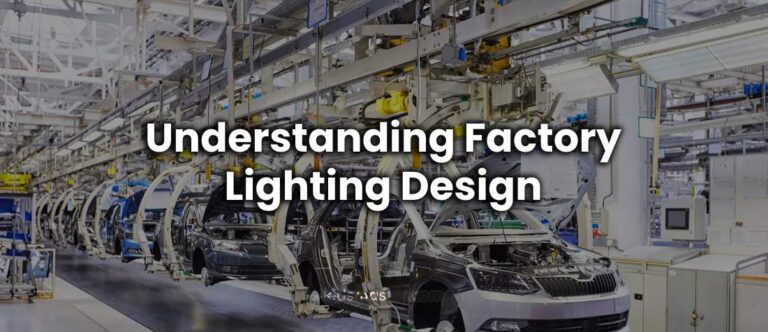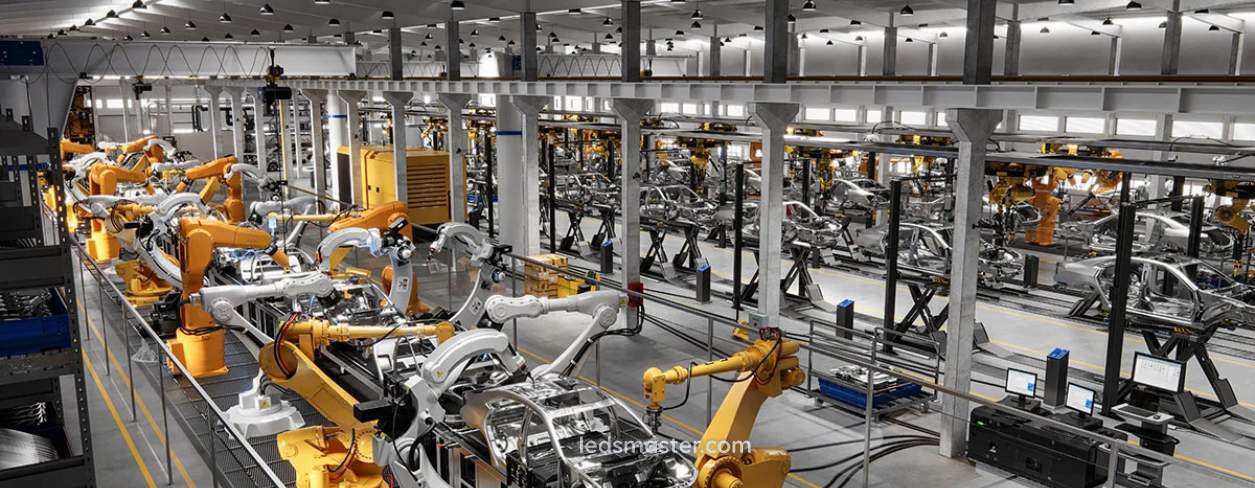
Factory lighting design focuses on creating efficient, safe, and productive industrial environments by addressing specific operational challenges. It involves strategically implementing lighting systems to ensure visibility, adapt to extreme conditions, and integrate advanced technologies like LED lighting and control systems for improved energy efficiency and reduced maintenance costs.
Get your complimentary lighting design today
As manufacturing environments become increasingly complex and diverse, the need for tailored lighting solutions grows. LED lighting has emerged as a key player in factory lighting design due to its numerous advantages, including energy efficiency, durability, and versatility. This article explores the nuances of factory lighting design, focusing on the benefits of LED technology and the specific requirements for various factory conditions.
LED lighting has revolutionized factory lighting design, offering significant benefits over traditional lighting options. One of the primary advantages is energy efficiency. LED lights consume significantly less power compared to incandescent or fluorescent bulbs, which translates to lower electricity bills and reduced environmental impact. Additionally, LEDs have a longer lifespan, reducing the frequency of replacements and minimizing maintenance costs. This longevity is particularly beneficial in industrial settings where high-ceiling fixtures are common, as it reduces the need for frequent and costly maintenance.
Table of Contents
ToggleFactories often present unique challenges that require specialized lighting solutions. These conditions include extreme temperatures, high humidity, and the need for enhanced durability. Each of these factors must be addressed to ensure that the lighting not only meets operational needs but also maintains safety and efficiency.
Factories operating in extreme temperatures, such as freezing environments or high-heat areas, require lighting fixtures designed to withstand these conditions. In frozen environments, LED lights must be rated for low temperatures to prevent issues such as reduced light output or fixture failure. Specialized LED fixtures designed for cold environments feature materials and components that remain functional in sub-zero temperatures. These fixtures often have sealed enclosures to prevent moisture ingress and to ensure consistent performance even in harsh conditions.
Conversely, factories with high-temperature operations, such as metal foundries or glass manufacturing, need lighting that can tolerate intense heat. LED lights used in these environments are equipped with heat-resistant materials and advanced thermal management systems to prevent overheating and ensure longevity. These fixtures are also designed to resist thermal cycling, which involves repeated exposure to extreme temperature fluctuations.

In factories where humidity is high or where corrosive substances are present, such as in chemical processing or food production, lighting fixtures must be resistant to moisture and chemical damage. LED fixtures with IP (Ingress Protection) ratings are essential in these environments. An IP rating indicates the level of protection a fixture has against dust and water. For instance, fixtures with an IP65 rating are dust-tight and protected against water jets, making them suitable for use in wet or humid conditions.
Corrosion-resistant coatings and materials are also crucial in factories where exposure to chemicals or saline environments is a concern. These coatings help to extend the life of the lighting fixtures and maintain their performance despite harsh conditions.
Effective factory lighting design goes beyond just choosing the right fixtures. Several factors must be considered to optimize lighting for both functionality and safety.
The illumination level, or lux level, required in a factory depends on the nature of the work being performed. For general tasks, a minimum of 300 lux is often sufficient, but more complex tasks such as precision machining or detailed inspection may require levels of up to 1000 lux or more. Uniformity is equally important, as uneven lighting can create shadows and reduce visibility, increasing the risk of accidents and decreasing productivity. Proper placement of lighting fixtures and the use of diffusers can help achieve uniform illumination across the workspace.
Safety is a paramount concern in factory lighting design. Adequate lighting is essential to prevent accidents and ensure that workers can perform their tasks safely. This includes not only general illumination but also task-specific lighting for activities requiring high precision. Ergonomic considerations are also important; lighting should be designed to minimize glare and reduce eye strain, which can lead to fatigue and decreased productivity. Adjustable fixtures and task lighting can help address these issues and improve overall working conditions.
Energy efficiency is a significant factor in factory lighting design, given the large number of fixtures typically required in industrial settings. LED technology offers substantial energy savings compared to traditional lighting options. Implementing controls such as occupancy sensors and daylight harvesting systems can further enhance energy efficiency by ensuring that lights are only on when needed. These controls can help reduce overall energy consumption and lower operational costs.
Maintenance is another critical aspect of factory lighting design. The durability of LED fixtures reduces the frequency of replacements and maintenance tasks, which is particularly beneficial in hard-to-reach areas. However, regular inspections and maintenance are still necessary to ensure optimal performance and address any issues promptly. Choosing fixtures with easy access for maintenance and incorporating features such as modular designs can facilitate this process.
One of the most significant advancements in factory lighting control is the integration with Building Management Systems (BMS). BMS are comprehensive platforms that manage various aspects of a building’s operations, including lighting, heating, ventilation, and air conditioning (HVAC). By connecting lighting systems to a BMS, factories can centralize control and automate lighting adjustments based on real-time data from other systems.
For instance, the BMS can adjust lighting levels based on occupancy data collected from sensors. In areas with high activity, lights can be brightened to ensure optimal visibility, while in less active zones, lighting can be dimmed or turned off to conserve energy. This integration not only enhances operational efficiency but also ensures that lighting conditions are always aligned with current factory needs.
The Internet of Things (IoT) has brought a new level of connectivity and intelligence to factory lighting systems. IoT-enabled lighting fixtures can communicate with each other and with central control systems, providing real-time data on various parameters such as energy consumption, light levels, and fixture health. This data can be analyzed to identify patterns, optimize lighting schedules, and predict maintenance needs.
Real-time monitoring allows facility managers to make immediate adjustments to lighting conditions based on current operational requirements. For example, if a production line experiences an unexpected increase in activity, the lighting system can automatically adjust to provide additional illumination. Conversely, if an area becomes vacant, the system can reduce lighting to save energy.
Dynamic lighting control is a key feature of advanced control systems that allows for flexible and adaptive lighting solutions. This capability includes adjusting light intensity, color temperature, and distribution in response to changing conditions or specific tasks. For example, in a factory where precision tasks are performed, lighting can be adjusted to higher intensities and cooler color temperatures to enhance visibility and reduce eye strain.
In contrast, areas where workers perform routine tasks might benefit from warmer, softer lighting that creates a more comfortable work environment. Dynamic controls can also simulate natural daylight patterns, supporting workers’ circadian rhythms and potentially improving their overall well-being and productivity.
Occupancy and motion sensors are integral to modern factory lighting control systems. These sensors detect the presence of people or equipment within a specific area and adjust lighting accordingly. In areas with intermittent activity, such as storage rooms or break areas, lights can be set to turn on only when motion is detected and automatically turn off after a period of inactivity.
Occupancy sensors contribute to energy savings by ensuring that lights are only used when needed, reducing unnecessary energy consumption. They also enhance safety by providing adequate lighting in areas as soon as they are occupied, thereby minimizing hazards and improving visibility for workers.
LED lighting has significantly transformed factory lighting design by providing superior energy efficiency, extended lifespan, and reduced maintenance requirements compared to traditional lighting options. As factories face diverse and challenging conditions such as extreme temperatures, high humidity, and corrosive environments, LED fixtures offer robust solutions tailored to these needs. Advanced control systems further enhance this transformation by integrating with Building Management Systems, leveraging IoT for real-time monitoring, and employing dynamic controls and sensors to optimize energy use and lighting performance. These innovations not only improve safety and productivity but also contribute to substantial cost savings and sustainability, setting a new standard for industrial lighting solutions.